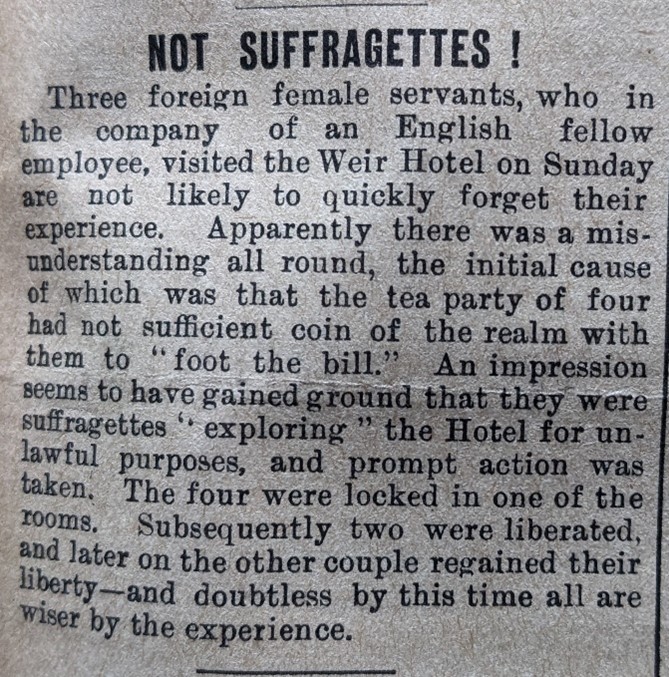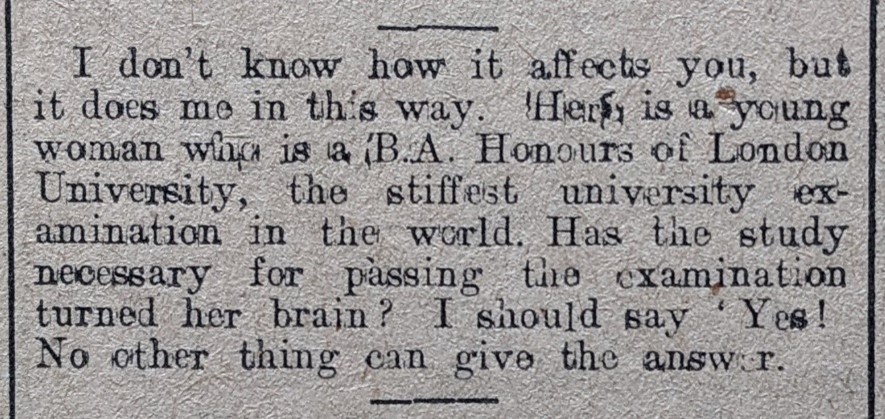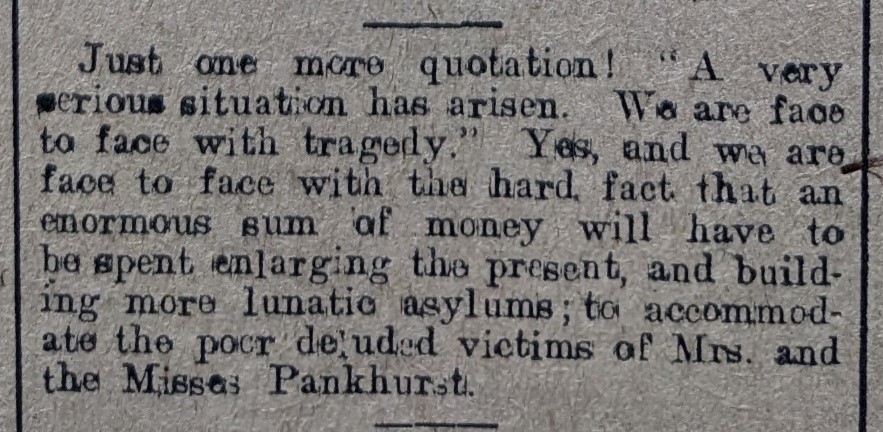“Terrorists?”: The Suffragette Arson and Bombing Campaign
The way that we treat the Suffragettes in popular culture, using their slogans and images on everything from posters, to t-shirts, to mugs and bookmarks, leads us to believe that while their actions were unlawful, their actions were fundamentally acceptable. Their militant actions have become palatable. We associate them with the words brave, inspirational and heroic. We view Emmeline Pankhurst’s (the leader of the Women’s Social and Political Union or WSPU) famous quote, “deeds not words”, as a call to political action and protest. They are our feminist heroes.
So, we would feel uncomfortable if anyone called them, dangerous, or killers or ‘terrorists’. We would feel uneasy at the fact that their actions killed at least four people and caused injuries to many others. We might be stunned, even shocked, to learn that they detonated a bomb at Westminster Abbey which damaged the Coronation Chair and (potentially) broke the Stone of Destiny. Or when we learn that they attempted to blow up a reservoir and flood villages in Upper Windleden, or detonated a bomb at Holloway Prison that covered sleeping children in shards of glass, or bombed schools, or threw bombs onto crowded train carriages and tube station platforms, or tried to burn down the tennis club house at Wimbledon, or bombed a Dublin theatre while the audience were still inside, or burnt down Kew Garden’s tea pavilion or planted a bomb that was powerful enough to destroy an entire building with 200 people inside – when we learn all of this, our ideas about the Suffragettes might shift.
If this information is new to you, if you did not know that the Suffragettes were engaged in a fierce arson and bombing campaign across Britain and Ireland, there is a reason for this. The history of the Suffragettes has been deliberately white-washed and toned down. These women have been made into window-smashers and post-box-burners. They have been made less violent, less angry, and less powerful. However, the Suffragettes were exactly all of those things. They were violent, they were angry, they were organised, determined and powerful.
Who’s Afraid of a Suffragette?

Egham Museum’s newspaper archive reveals a glimpse at the panic and fear that surrounded the Suffragettes. One article from The Surrey Herald on 28 March 1913 explained how the staff in their Woking office ‘were startled by a crash of glass followed by a heavy thud. Visions of a Suffragette raid – hammers, stones, acid, etc., rose before one’s eyes.’ However, to their ‘relief’ a car had simply backed into a lamppost which had fallen over and smashed the glass window. This reveals the atmosphere of fear that the Suffragettes had created. The sound of broken glass was associated with their attacks. There had been another notable case of ‘Not Suffragettes!’ (as The Surrey Herald put it) on 7 March 1913. At the Weir Hotel in Egham, ‘three foreign female servants’ and an English man were accused of being Suffragettes, ‘“exploring” the Hotel for unlawful purposes’. They were then locked in a room. The newspaper notes that they did ‘regain their liberty – and doubtless by this time all are wiser by the experience’.
Photo Credit: The Surrey Herald, 7 March 1913.
The people of Egham and the surrounding areas had every right to be on edge, and soon their fears were realised when Trevethan House was burnt down in Englefield Green. While Egham Fire Brigade did attempt to put out the fire, according to The Morning Post they had no water so ‘had to stand there… watching the place burn itself out’. Around £5000 of damage was caused, about £475,000 in today’s money, and messages were left reading “Votes for Women” and “Stop torturing our comrades in prison”.
Olive Beamish was one of the Suffragettes who was found guilty of arson. Beamish was born in 1890 in Cork, Ireland and joined the WSPU when she was 16 years old. For the fire at Trevethan, she was sentenced to 18 months in prison. She was force-fed in prison and probably given doses of bromide which made the body relax to make force feeding easier. In 1914, Dr Flora Murray produced a report that started that the ‘administration of bromide… could include long term mental impairment.’
Elise Duval was the other Suffragette implicated in the Trevethan fire. She was born in 1892 and joined the WSPU in 1907. She was sentenced to five years of imprisonment with hard labour but was released under the Cat and Mouse Act after going on hunger strike. This act allowed Suffragettes who were near death to be released, and they would be re-arrested when their health improved. Duval died on 1 January 1919 due to heart failure, caused by the influenza virus and septic pneumonia. She had noted in her diary that after being force-fed she had experienced heart pains.
Emily Wilding Davison
Emily Wilding Davison was also more militant than history would like us to think. It was Davison, in the December of 1911, who first set fire to a pillar box – without the authorisation of the WSPU. In November 1912, she whipped a man in Aberdeen who she thought was MP David Lloyd George. Some historians suggest that she was involved in the bombing of Lloyd George’s house in February 1913, but others suggest that this was not the case.
Some of the public were also not as sympathetic as we are today to her last, fatal act. When Davison was dying, after being trampled by the King’s horse at the Epsom Derby, some readers of The Surrey Herald wrote to the newspaper, expressing their thoughts on the matter.
Look out for these opinions on Egham High Street in ‘The Mystery of the Missing Suffragette’.
Some historians have called the extreme Suffragettes ‘terrorists’. This word does not sit comfortably among our long-held ideas about these men and women. Nevertheless, the Suffragettes wanted attention, they wanted outrage, they wanted to spark fear. The Suffragettes did not only engage in ‘civil disobedience’ and ‘vandalism’. They killed people with their actions and had the potential to kill hundreds more. When we see the phrase “deeds not words” we must remember that this was a call to arms, a call to increase their arson and bombing attacks. “Deeds not words” is not a simple, feminist slogan. It was an instruction to an army that was prepared to kill and maim in their fight for the right to vote.
Consider the moral dilemmas that these women faced in ‘The Mystery of the Missing Suffragette’.
To raise funds for their cause, and improve their supporters’ strategic thinking skills, the Suffragettes launched a series of games. Read the next blog to find out more!
Travel back to 1913 by playing the free online puzzle game ‘The Mystery of the Missing Suffragette’ to learn more about the Suffragettes’ violence. Visit Royal Holloway and Egham, attend The Egham and District Women’s Suffrage Society meeting, and use your puzzle-solving skills to uncover the truth about “Mary Dean”. Immersive yourself in their world and consider the difficult decisions they faced. This game is suitable for ages 14 and over.
Further Reading:
‘Letter bombs and IEDs: Were the suffragettes terrorists?’, Sky News, https://news.sky.com/story/women-would-have-got-the-vote-earlier-if-not-for-suffragette-terrorists-11227772
‘Can we call the suffragettes terrorists? “Absolutely,” says Fern Riddell’, History Extra, https://www.historyextra.com/period/edwardian/kitty-marion-were-suffragettes-violent-terrorists-fern-riddell/
‘Were extreme suffragettes regarded as terrorists?’, BBC News, https://www.bbc.co.uk/news/magazine-16945901




We’re a group of volunteers and opening a new scheme in our community. Your web site provided us with valuable information to work on. You’ve done an impressive job and our whole community will be thankful to you.
Great website you have here but I was curious if you knew of any community forums that cover the same topics discussed in this article? I’d really love to be a part of online community where I can get responses from other experienced people that share the same interest. If you have any suggestions, please let me know. Kudos!